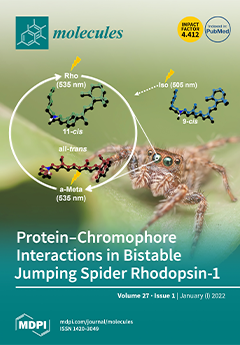We characterized the stationary points along the nucleophilic substitution (S
N2), oxidative insertion (OI), halogen abstraction (XA), and proton transfer (PT) product channels of M
− + CH
3X (M = Cu, Ag, Au; X = F, Cl, Br, I) reactions
[...] Read more.
We characterized the stationary points along the nucleophilic substitution (S
N2), oxidative insertion (OI), halogen abstraction (XA), and proton transfer (PT) product channels of M
− + CH
3X (M = Cu, Ag, Au; X = F, Cl, Br, I) reactions using the CCSD(T)/aug-cc-pVTZ level of theory. In general, the reaction energies follow the order of PT > XA > S
N2 > OI. The OI channel that results in oxidative insertion complex [CH
3–M–X]
− is most exothermic, and can be formed through a front-side attack of M on the C-X bond via a high transition state OxTS or through a S
N2-mediated halogen rearrangement path via a much lower transition state invTS. The order of OxTS > invTS is inverted when changing M
− to Pd, a d
10 metal, because the symmetry of their HOMO orbital is different. The back-side attack S
N2 pathway proceeds via typical Walden-inversion transition state that connects to pre- and post-reaction complexes. For X = Cl/Br/I, the invS
N2-TS’s are, in general, submerged. The shape of this M
− + CH
3X S
N2 PES is flatter as compared to that of a main-group base like F
− + CH
3X, whose PES has a double-well shape. When X = Br/I, a linear halogen-bonded complex [CH
3−X∙··M]
− can be formed as an intermediate upon the front-side attachment of M on the halogen atom X, and it either dissociates to CH
3 + MX
− through halogen abstraction or bends the C-X-M angle to continue the back-side S
N2 path. Natural bond orbital analysis shows a polar covalent M−X bond is formed within oxidative insertion complex [CH
3–M–X]
−, whereas a noncovalent M–X halogen-bond interaction exists for the [CH
3–X∙··M]
− complex. This work explores competing channels of the M
− + CH
3X reaction in the gas phase and the potential energy surface is useful in understanding the dynamic behavior of the title and analogous reactions.
Full article






